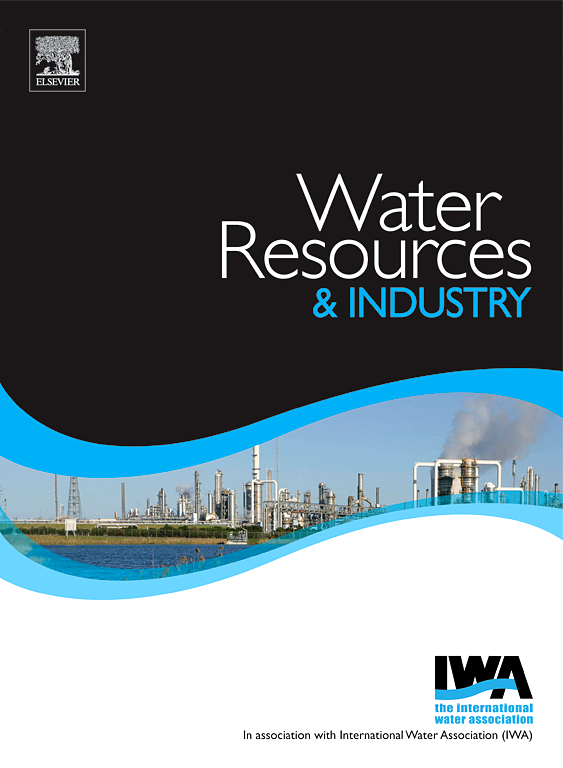Development of a methodology for identifying and quantifying mining environmental liabilities in aquatic ecosystems: A case study of Segovia, Colombia
IF 4.5
3区 工程技术
Q1 WATER RESOURCES
引用次数: 0
Abstract
Untreated discharges from mining activities threaten aquatic ecosystems, affecting water quality and biodiversity. This study develops a methodology for estimating environmental liabilities in aquatic systems, focusing on Segovia, Colombia (2010–2017). Using historical data (2010–2017), recent monitoring (2021–2023), and modelling tools (HEC-RAS and WASP), water and sediment quality indices were applied to quantify impacts, emphasizing heavy metals and cyanide. The methodology integrated diverse indices to evaluate contamination levels, including the Aquatic Toxicity Index (ATI) for water quality and the Pollutant Load Index (PLI) for sediments. Results revealed increased contaminant concentrations downstream, such as lead (0.4 mg/L) and suspended solids (61 mg/L), exceeding regulatory limits. While local pressures like domestic and illegal mining discharges complicate the pollution scenario, the findings confirm significant environmental liabilities from untreated discharges, impacting ecosystem services and community health. The study demonstrates that, despite pre-existing contamination, mining activities notably degrade water and sediment quality. It highlights critical deposition zones where contaminants accumulate, serving as focal points for remediation. The developed methodology offers a replicable framework, integrating past and current data, modelling, and tailored indices to assess aquatic liabilities effectively. This research provides actionable insights for mitigating mining pollution and restoring affected ecosystems. Bridging gaps in environmental liability quantification supports informed decision-making for environmental management and policy development in mining-impacted regions.
制定查明和量化水生生态系统采矿环境责任的方法:哥伦比亚塞戈维亚个案研究
采矿活动未经处理的排放威胁着水生生态系统,影响水质和生物多样性。本研究开发了一种估算水生系统环境负债的方法,重点是哥伦比亚塞戈维亚(2010-2017)。利用历史数据(2010-2017年)、近期监测数据(2021-2023年)和建模工具(HEC-RAS和WASP),应用水和沉积物质量指数来量化影响,重点关注重金属和氰化物。该方法综合了多种指标来评估污染水平,包括水质的水生毒性指数(ATI)和沉积物的污染物负荷指数(PLI)。结果显示,下游的污染物浓度增加,如铅(0.4 mg/L)和悬浮固体(61 mg/L),超过了监管限制。虽然家庭和非法采矿排放等当地压力使污染情况复杂化,但研究结果证实,未经处理的排放会造成严重的环境责任,影响生态系统服务和社区健康。研究表明,尽管存在污染,采矿活动显著降低了水和沉积物的质量。它突出了污染物积聚的关键沉积带,作为修复的焦点。开发的方法提供了一个可复制的框架,整合了过去和当前的数据、建模和量身定制的指数,以有效评估水生责任。这项研究为减轻采矿污染和恢复受影响的生态系统提供了可行的见解。缩小环境责任量化方面的差距有助于为受采矿影响地区的环境管理和政策制定作出知情决策。
本文章由计算机程序翻译,如有差异,请以英文原文为准。
求助全文
约1分钟内获得全文
求助全文
来源期刊

Water Resources and Industry
Social Sciences-Geography, Planning and Development
CiteScore
8.10
自引率
5.90%
发文量
23
审稿时长
75 days
期刊介绍:
Water Resources and Industry moves research to innovation by focusing on the role industry plays in the exploitation, management and treatment of water resources. Different industries use radically different water resources in their production processes, while they produce, treat and dispose a wide variety of wastewater qualities. Depending on the geographical location of the facilities, the impact on the local resources will vary, pre-empting the applicability of one single approach. The aims and scope of the journal include: -Industrial water footprint assessment - an evaluation of tools and methodologies -What constitutes good corporate governance and policy and how to evaluate water-related risk -What constitutes good stakeholder collaboration and engagement -New technologies enabling companies to better manage water resources -Integration of water and energy and of water treatment and production processes in industry
 求助内容:
求助内容: 应助结果提醒方式:
应助结果提醒方式:


